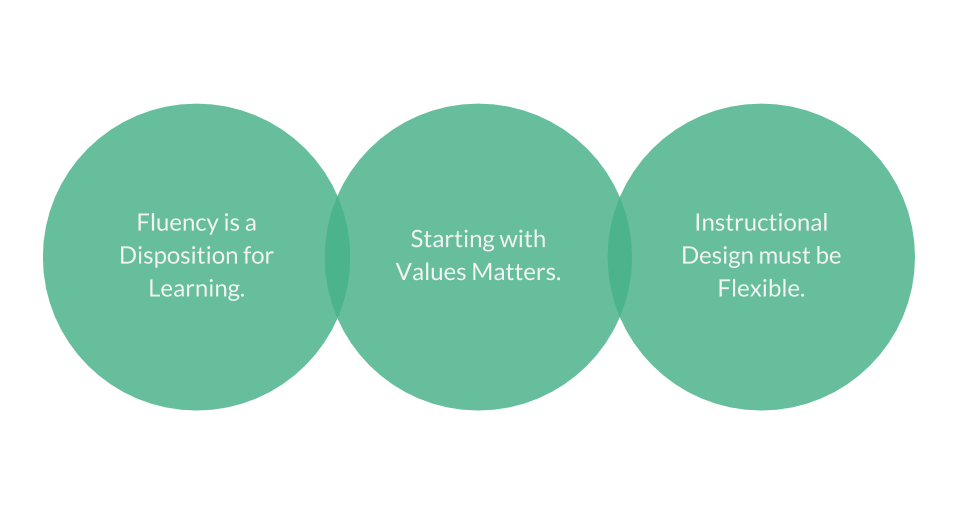The exploratory year of the Fluency Project has been one of authentic inquiry. Posing a genuine question and following it to create and document an emerging knowledge base is a deliberate and arduous process. Investing in the effort to develop students as thought leaders and in teacher practices that relentlessly support student voice is one of the yet unanswered questions about learning and educational processes in our nation’s schools.
A compelling lesson learned was that data fluency was implemented successfully in all school contexts and at all grade levels as developmentally appropriate tasks. During its Exploring Fluency year, the Fluency Project promoted the advancement of student voice via productions such as but not limited to robotics, animation, podcasts, narrated 360 degree images, oration, moviemaking, digital design in 2D and 3D, and data visualization. These courses of study (from grades 2 to 12) productively implemented requirements for using numerical data to support student-constructed narratives.
Students also inversely constructed compelling points of view when they assessed data pools from internal and external sources and used the data to search out individualized narratives. Through inquiry, teachers were willing to commit themselves to reflective instructional practices that in turn committed their students to deeper learning. As one participant reflected, “Fluency challenged me to think about bigger issues. It challenged me to get my students to do the same and then tackle these bigger issues.” Furthermore, “Fluency is student-based and passion-driven. Students tell what happened, what they learned, and why people should care.”
The Fluency Project empowered teachers as a CREATE based cohort to experiment with teaching strategies they had previously not explored. Basing Fluency in a values framework created an inexorable bond between the diversely situated educators and the CREATE Team. Their teaching contexts and their student needs were distinct. Yet our shared thinking about student empowerment was embedded in stated values including relationships, equity, inquiry, safety, choice, transparency, power hierarchies, and numbers and narratives. Our shared values built collegiality and encouraged teachers to take risks. The license to explore yielded both stronger teacher voice and resulted in personalized learning for their students in what had previously been traditional learning environments. Hence, as a cohort of inquirers, teacher participants successfully created in-school structures that advance and validate student voice.
A compelling lesson learned was that data fluency was implemented successfully in all school contexts and at all grade levels as developmentally appropriate tasks. During its Exploring Fluency year, the Fluency Project promoted the advancement of student voice via productions such as but not limited to robotics, animation, podcasts, narrated 360 degree images, oration, moviemaking, digital design in 2D and 3D, and data visualization. These courses of study (from grades 2 to 12) productively implemented requirements for using numerical data to support student-constructed narratives.
Students also inversely constructed compelling points of view when they assessed data pools from internal and external sources and used the data to search out individualized narratives. Through inquiry, teachers were willing to commit themselves to reflective instructional practices that in turn committed their students to deeper learning. As one participant reflected, “Fluency challenged me to think about bigger issues. It challenged me to get my students to do the same and then tackle these bigger issues.” Furthermore, “Fluency is student-based and passion-driven. Students tell what happened, what they learned, and why people should care.”
The Fluency Project empowered teachers as a CREATE based cohort to experiment with teaching strategies they had previously not explored. Basing Fluency in a values framework created an inexorable bond between the diversely situated educators and the CREATE Team. Their teaching contexts and their student needs were distinct. Yet our shared thinking about student empowerment was embedded in stated values including relationships, equity, inquiry, safety, choice, transparency, power hierarchies, and numbers and narratives. Our shared values built collegiality and encouraged teachers to take risks. The license to explore yielded both stronger teacher voice and resulted in personalized learning for their students in what had previously been traditional learning environments. Hence, as a cohort of inquirers, teacher participants successfully created in-school structures that advance and validate student voice.

